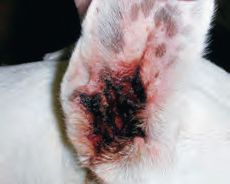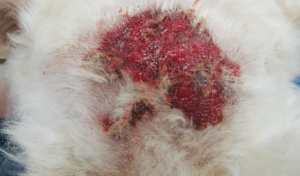Ah-CHOO! Is that what you think of when I mention allergies?
In humans, the organ of allergic expression is the respiratory tract. We get hay fever, asthma, all sorts of respiratory symptoms from our body’s over-reaction to allergens.
Well, in dogs, the organ of allergic expression is skin. The parts of the skin most affected by the allergic reaction are the parts that have the most histamine-receptors; histamine is the “signal-chemical” of the allergic response. These parts are the face (including ears), and the “undercarriage”: feet, belly, armpits and bum.
What happens to the skin can be plain old itching, in the absence of any sort of skin lesions.
Or, you can see outright inflammation of the skin, showing up as:
- Redness, sometimes in a very blotchy fashion. Between the toes is a good place to look for glaring red skin.
- Rashes – these can range from little red bumps, to whiteheads, to crusty scabs.
- Hair thinning or loss – hair follicles do not like being consistently “baked” by inflammation.
- Oil imbalances – skin being either too dry and flaky, or overtly greasy. Skin oil glands don’t like being “baked” either.
- Predisposition to infection.

- Ear infections are a big one here; after all, what are ear canals but tubes lined by skin? If all the skin is inflamed, the heat and moisture is caught and amplified by the canal, making a perfect incubator to grow pathogens.
- Hot spots can result when skin stays wet after a very furry dog lays down for a snooze after swimming.
 The moisture macerates (softens and breaks) the surface skin layers, letting bacteria set up occupancy. But, if your dog gets a lot of them, that is suggesting the skin was already halfway there with inflammation in the first place.
The moisture macerates (softens and breaks) the surface skin layers, letting bacteria set up occupancy. But, if your dog gets a lot of them, that is suggesting the skin was already halfway there with inflammation in the first place. - Skin yeast infections (Malessezia yeast) happily take root in the welcoming warm, moist environment of inflamed skin, especially in places like facial folds, folds around the vulva, or the spaces between the toes (especially the underside where the sweat glands add their own moisture). When the yeast growth is heavy, the waste products they produce irritate the skin, and add to the inflammation (making it even more warm and moist. Happy yeast!) To add to that: if one of the things the dog is allergic to turns out to be skin yeast, now you really have a vicious cycle! You can recognize skin yeast by the orange brown colour it turns the hair, and the waxy brown discharge that builds up.
The allergic response is kind of like climbing the rungs of a ladder: how many things you are reacting too, ie how high you climb, determines:
a) whether you cross the threshold for displaying allergic symptoms
b) how bad those symptoms are.
Allergies can be to ingredients in food, or to things in the environment (mould spores, pollens, dust mite feces). Some general guidelines to suggest one or the other:
- Seasonality. If the severity of the allergic signs never really changes, that hints more at food – after all, a dog has to eat food every day of his life! If you see signs are worse with certain times of year, that suggests environmental allergies, as moulds and pollens do have seasons. There are some environmental allergens that are not so seasonal though: dust mites and cigarette smoke, for example are not seasonal (although symptoms may be a bit worse in winter when the house is closed up the the air keeps getting recirculated). And yes, there are cases of dogs that have turned out to be allergic to people!
- Age of onset. For seasonal allergies, the dog generally has to have been through a few cycles of exposure before the immune system is sensitized enough to an allergen to start having immunologic hissy-fits. This means the average age of onset of signs for seasonal allergies is 2-5 years of age. The build-up of exposure is a lot faster for food allergies – again, the dog has to eat every day of his life! Allergies that start under 2 years of age are more likely to be food-related – I have seen cases confirmed in puppies as young as 3 months!
- Distribution of affected areas – this one is a bit more “iffy”, but there is a suggestion that food allergies affect the trunk of the body more, and environmental allergies affect the extremities more such as face and feet. Ears are affected by both types of allergies. This is not exclusive, though, I have seen allergies that suggest one pattern turn out to be the other type.

